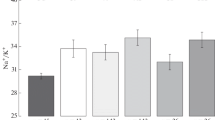Summary
The effect of plasma infusions on the excretion of water and salt by 5 normotensive and 5 hypertensive subjects was compared. Following the infusion of a 5 per cent glucose solution for about 3 hours, reconstituted plasma was infused at a rate of 5.2 ml./min.
All the normotensive subjects responded with a decrease in urinary flow, the free water clearance becoming negative. The excretion of salt was not consistently changed.
In contrast, four of the hypertensive subjects showed an increase in urinary flow with a corresponding rise in free water clearance; one subject showed a slight decrease in urinary flow, the free water clearance remaining positive. Salt excretion was essentially unchanged.
The antidiuretic effect observed in the normotensive subjects is ascribed to the presence of antidiuretic material in the infused plasma. In the hypertensive subjects, the effect of this material was counteracted by a water diuresis, resulting from the expansion of the plasma volume.
It is concluded that hypertensive subjects possess a higher sensitivity to plasma volume expansion than normotensive subjects.
Zusammenfassung
Der Einfluß von Plasmainfusionen auf die Ausscheidung von Wasser und Salz bei je 5 normotensiven und hypertensiven Versuchspersonen wurde verglichen. Die Plasmainfusionen, hergestellt aus getrocknetem Plasma, wurden infundiert, nachdem während ungefähr 3 Std. eine 5% ige Traubenzuckerlösung gegeben worden war. Das Plasma wurde mit einer konstanten Geschwindigkeit von 5.2 cc pro Minute gegeben.
Bei allen normalen Versuchspersonen wurde ein Abfall der Urinmenge beobachtet, wobei die Ausscheidung von „freiem Wasser” negativ wurde. Die Ausscheidung von Salz zeigte keine regelmäßige Veränderungen.
Im Gegensatz hierzu zeigten 4 der hypertensiven Versuchspersonen einen Anstieg der Urinausscheidung mit einem entsprechenden Anstieg in der Ausscheidung von „freiem Wasser”; in einem Fall wurde ein leichter Abfall der Urinausscheidung beobachtet, jedoch blieb auch in diesem Falle die Ausscheidung von „freiem Wasser” positiv. Die Salzausscheidung war im wesentlichen nicht verändert.
Die in den normalen Versuchspersonen gefundene Antidiurese wird zurückgeführt auf die Anwesenheit von antidiuretischen Stoffen, die sich im infundierten Plasma befanden. Diese Stoffe jedoch konnten in den hypertensiven Versuchspersonen ihre volle Wirkung nicht entfalten, da in diesen Personen durch die Ausdehnung des Plasmavolumens eine die Antidiurese überschattende Wasserdiurese verursacht wurde. Hieraus ergibt sich die Folgerung, daß bei Hypertonikern eine größere Reaktionsbereitschaft gegenüber der Ausdehnung des Plasmavolumens besteht als dies bei normalen Personen der Fall ist.
Similar content being viewed by others
References
Brodsky, W. A. andH. N. Graubarth, J. Lab. Clin. Med.41, 43 (1953).
Green, D. M., H. G. Wedell, M. H. Wald, andB. Learned, Circulation6, 919 (1952).
Birchall, R., S. W. Tuthill, W. S. Jacobs, W. J. Trautman, andT. Findley, Circulation7, 258 (1953).
Thompson, J. E., T. F. Silva, D. Kinsey, andR. H. Smithwick, Circulation10, 912 (1954).
Hollander, W. andW. E. Judson, J. Clin. Invest.36, 1460 (1957).
Ullmann, T. D., S. H. Blondheim, S. Dikstein, andD. Ben-Ishay, Circulation19, 729 (1959).
Roe, J. H., J. H. Epstein, andN. P. Goldstein, J. Biol. Chem.178, 839 (1949).
Wilson, J. R., jr., andC. R. Harrison, J. Clin. Invest.29, 251 (1950).
Brun, C., E. O. E. Knudsen, andF. Raaschou, J. Clin. Invest.25, 568 (1946).
Van Dyke, H. B., K. Adamsons, jr., andS. L. Engel, Rec. Progr. Hormone Research11, 1 (1955).
Thorn, N. A., Physiol. Rev.38, 169 (1958).
Hollander, W., Circulation19, 691 (1959).
Smith, H. W., Amer. J. Med.23, 623 (1957).
Sieker, H. O., O. H. Gauer, andJ. P. Henry, J. Clin. Invest.33, 572 (1954).
Hulet, W. H. andH. W. Smith, J. Clin. Invest.38, 1972 (1959).
Borst, J. G. G., in „The Kidney”, Ciba Foundation Symposium (London 1954).
Braun-Menendez, E., in „Hypertension”, A Symposium (Minneapolis 1951.
Sapirstein, L. A. in „Hypertension” (Philadelphia and London 1959).
Author information
Authors and Affiliations
Additional information
Supported by a grant from the Hadassah Medical Organization Research Fund. —Dedicated to Prof.Bruno Kisch M.D. on occasion of his 70th birthday.
With 2 figures and 2 tables
Rights and permissions
About this article
Cite this article
Ullmann, T.D., Czaczkes, W.J. Increased sensitivity of a volume regulating mechanism in the hypertensive state. Archiv für Kreislaufforschung 33, 137–144 (1960). https://doi.org/10.1007/BF02119764
Received:
Issue Date:
DOI: https://doi.org/10.1007/BF02119764



